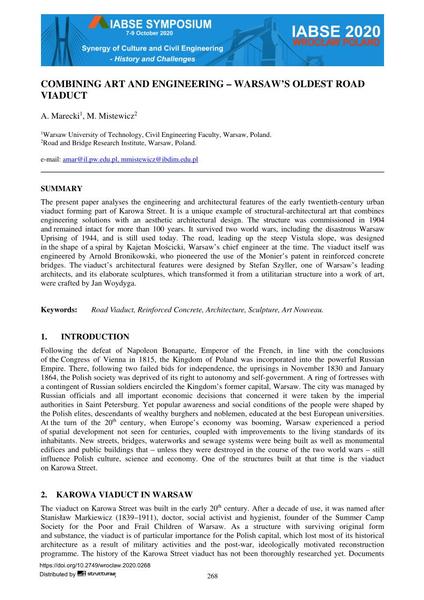Combining Art and Engineering – Warsaw’s Oldest Road Viaduct

|
|
|||||||||||
Bibliografische Angaben
| Autor(en): |
A. Marecki
M. Mistewicz |
||||
|---|---|---|---|---|---|
| Medium: | Tagungsbeitrag | ||||
| Sprache(n): | Englisch | ||||
| Tagung: | IABSE Symposium: Synergy of Culture and Civil Engineering – History and Challenges, Wrocław, Poland, 7-9 October 2020 | ||||
| Veröffentlicht in: | IABSE Symposium Wroclaw 2020 | ||||
|
|||||
| Seite(n): | 268-275 | ||||
| Anzahl der Seiten (im PDF): | 8 | ||||
| Jahr: | 2020 | ||||
| DOI: | 10.2749/wroclaw.2020.0268 | ||||
| Abstrakt: |
The present paper analyses the engineering and architectural features of the early twentieth-century urban viaduct forming part of Karowa Street. It is a unique example of structural-architectural art that combines engineering solutions with an aesthetic architectural design. The structure was commissioned in 1904 and remained intact for more than 100 years. It survived two world wars, including the disastrous Warsaw Uprising of 1944, and is still used today. The road, leading up the steep Vistula slope, was designed in the shape of a spiral by Kajetan Mościcki, Warsaw’s chief engineer at the time. The viaduct itself was engineered by Arnold Bronikowski, who pioneered the use of the Monier’s patent in reinforced concrete bridges. The viaduct’s architectural features were designed by Stefan Szyller, one of Warsaw’s leading architects, and its elaborate sculptures, which transformed it from a utilitarian structure into a work of art, were crafted by Jan Woydyga. |
||||
| Stichwörter: |
Architektur Stahlbeton Skulptur
|
||||
